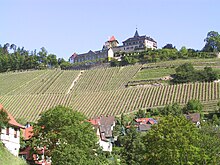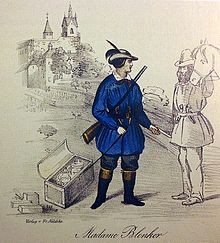Eberstein Castle (Gernsbach)

The Eberstein Castle , also New Eberstein or Neueberstein called, is a castle in Gernsbach - Obertsrot in Baden-Württemberg district Rastatt . It is originally a spur castle of the Counts of Eberstein with a shield wall on the slope, the mountain side of which was reinforced by the rectangular keep . The complex was expanded several times and converted into a country palace at the beginning of the 19th century by the Baden ruling family. Today Eberstein Castle is used as a hotel, restaurant, winery and private residence.
Geographical location
The castle is 130 meters above the Murg valley floor on a mountain nose in the north of the Obertsrot district of Gernsbach , which marks the transition from the deeply cut central Murg valley to the lower Murg valley, which widens near Gernsbach. The exposed on the slope to Murg rock from Forbach Granite is as Count jump known. A legend about Count Wolf von Eberstein is connected with him.
A road connection exists via the district road 3701, which leads from the Gernsbach core town to the castle and on to Müllenbild and via the state road 78 to Baden-Baden -Oberbeuern. The next access by public transport is the Obertsrot stop of the Murg Valley Railway , from which the castle complex can be reached via a 1.5-kilometer section of the Murgleiter premium hiking trail .
history
Neu-Eberstein was first mentioned as Novum Castrum Eberstein in 1272 and, in addition to Alt-Eberstein Castle, served as the seat of the lords of the Eberstein County . Otto I. von Eberstein (1207–1279) is considered the builder and first lord of the castle. The shield wall and the stump of the keep are among the oldest components . The complex was significantly expanded in the 16th century under Wilhelm IV von Eberstein (1497–1562), who had fountains, stair towers, the upper floor of the residential building, an archive building, a castle chapel and various walls built. In the early 17th century, Philip III. von Eberstein († 1609) added the new gatehouse, the outer works in the east and west as well as additional walls.
After their extinction with the death of Count Casimir (1639–1660), the property of the Ebersteiner fell partly to the margraviate of Baden and partly to Württemberg-Neuenstadt . In the future, the complex was no longer used as a manor house, but was only the residence of the Baden and Württemberg administrators. At the time of the Palatinate War of Succession , the castle was a safe place for Prince Leopold Wilhelm , the Baden-Baden archives and for the nuns of the Holy Sepulcher . In 1691 part of the complex burned down. After that, the castle was only used as a workshop and warehouse.
Over time, the Württemberg shares of the former Eberstein property gradually came to Baden. In 1798 the Margrave of Baden, Karl Friedrich, handed the complex over to his son Friedrich. From 1802 he had the castle converted into a palace in the neo-Gothic style by the Karlsruhe builder Friedrich Weinbrenner .
From around 1830, under Grand Duke Leopold , the buildings were redesigned in a neo-Gothic style. According to plans by Weinbrenner's student Heinrich Hübsch , today's restaurant building was also built in place of the old stables. The executive foreman Johann Belzer was also responsible for further renovations in the late 19th century. Grand Duke Leopold also acquired numerous art treasures that he exhibited in the palace, including historical glass paintings and the like. a. from the parish church in Dühren and Ottersweier , a Gothic crucifixion group from 1464 from the former Cistercian monastery in Herrenalb and Romanesque reliefs from the 12th century from the demolished monastery church in Petershausen . Leopold had the house chapel furnished with paintings by Moritz von Schwind and the court painter Albert Graefle .
During the Baden Revolution , at the end of June 1849, Palatine militants under the command of Ludwig Blenker and Elise Blenker plundered the castle.
The local poet, gardener and farmer Heinrich Würtenberger worked as a castle administrator at Eberstein Castle in the late 19th and early 20th centuries. In 1902, Grand Duke Friedrich I appointed him economic councilor.
The keep got its present shape in 1951 according to plans by Otto Linde .
In 2000, Max Markgraf von Baden sold the castle to Gerd Overlack, a Cologne- based industrial insurance broker from Gernsbach, who also bought Gymnich Castle in 2012 . He had the listed castle extensively restored. The vineyard was also newly laid out and terraced on five hectares facing south. The vineyard had been cleared by the margrave in 1994 because the management no longer seemed profitable. The clearing had led to considerable resentment in Gernsbach and Obertsrot, as the vineyard shapes the landscape.
Todays use
With Werner's Restaurant , a gourmet restaurant is housed in the castle, with a star in since 2006 Michelin Guide is excellent, and a 4-star hotel. The castle is also a popular destination for hikers and day-trippers, among other things because of the castle tavern with the associated plane-tree terrace beer garden and the associated view of the central Murg valley . Due to private ownership, there are no guided tours of the palace.
Thanks to the new owner and his brother Jörg, the viticulture on the slope below the castle , which had only been discontinued a few years earlier and had been in operation for centuries, was brought back to life. The winery belongs to the Ortenau wine-growing region and is located on the Ortenauer Weinpfad hiking trail . The arboretum Schloss Eberstein arboretum trail runs around the Schlossberg . The castle is a station on the Gernsbacher Runde hiking trail and the Gernsbacher saga trail .
On the winding road ascent from the Gernsbacher Murginsel, the local motorsport association Automobilclub Eberstein eV (ACE) held the Schloßbergrennen motorsport event 14 times between 1970 and 1989 . Since 2004, based on these races, a meeting for oldtimer and youngtimer vehicles with a so-called regularity drive competition has been held annually on a weekend under the name Schlossberg-Historic .
Eberstein Castle was named Monument of the Month for January 2008 by the Baden-Württemberg Monument Foundation.
literature
- Wolfgang Froese, Martin Walter (Ed.): Eberstein Castle. People, history, architecture . (Special publication of the Rastatt District Archives, Volume 7). Casimir Katz Verlag, Gernsbach 2009, ISBN 978-3-938047-46-0 .
- Gerhard Hoffmann: The Neu-Eberstein Castle . In: Hugo Schneider (Ed.): Castles and palaces in central Baden . (Series of publications: Die Ortenau: Journal of the Historical Association for Central Baden , Volume 64). Verlag des Historisches Verein für Mittelbaden, Offenburg 1984, ISSN 0342-1503 , pp. 73–82.
- Joachim Kleinmanns: Neu-Eberstein Castle near Baden-Baden. On the preservation of historical monuments in the 19th and 20th centuries . In: Castle Renaissance in Historicism . (Series of publications: Research on castles and palaces , Volume 10). Deutscher Kunstverlag, Munich / Berlin 2007, ISBN 978-3-422-06718-9 , pp. 129-146.
- Konrad Krimm: Castles of the House of Baden . In: Jürgen Krüger, Hansmartin Schwarzmaier et al. (Hrsg.): The medieval picture of the 19th century on the Upper Rhine . (Series of publications: Upper Rhine Studies , Volume 29). Thorbecke, Ostfildern 2004, ISBN 3-7995-7822-6 , pp. 77-95.
- Eberstein Castle - Where history and pleasure meet - Flyer of the city of Gernsbach ( PDF ), Touristinfo Gernsbach (1.8 MB)
- Arboretum Schloss Eberstein - Arboretum nature trail - Flyer of the city of Gernsbach ( PDF ), Touristinfo Gernsbach (1.8 MB)
Web links
- Eberstein Castle on the site of the city of Gernsbach
- Hotel Schloss Eberstein
- Eberstein Castle Winery
- Schlossberg Historic
- Eberstein Castle near palaces and castles in Baden-Württemberg
Coordinates: 48 ° 44 ′ 58 ″ N , 8 ° 20 ′ 35 ″ E



